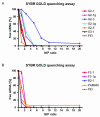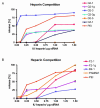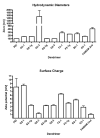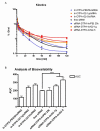Triazine dendrimers as nonviral vectors for in vitro and in vivo RNAi: the effects of peripheral groups and core structure on biological activity
- PMID: 20524664
- PMCID: PMC2914146
- DOI: 10.1021/mp100101s
Triazine dendrimers as nonviral vectors for in vitro and in vivo RNAi: the effects of peripheral groups and core structure on biological activity
Abstract
A family of triazine dendrimers, differing in their core flexibility, generation number, and surface functionality, was prepared and evaluated for its ability to accomplish RNAi. The dendriplexes were analyzed with respect to their physicochemical and biological properties, including condensation of siRNA, complex size, surface charge, cellular uptake and subcellular distribution, their potential for reporter gene knockdown in HeLa/Luc cells, and ultimately their stability, biodistribution, pharmacokinetics and intracellular uptake in mice after intravenous (iv) administration. The structure of the backbone was found to significantly influence siRNA transfection efficiency, with rigid, second generation dendrimers displaying higher gene knockdown than the flexible analogues while maintaining less off-target effects than Lipofectamine. Additionally, among the rigid, second generation dendrimers, those with either arginine-like exteriors or peripheries containing hydrophobic functionalities mediated the most effective gene knockdown, thus showing that dendrimer surface groups also affect transfection efficiency. Moreover, these two most effective dendriplexes were stable in circulation upon intravenous administration and showed passive targeting to the lung. Both dendriplex formulations were taken up into the alveolar epithelium, making them promising candidates for RNAi in the lung. The ability to correlate the effects of triazine dendrimer core scaffolds, generation number, and surface functionality with siRNA transfection efficiency yields valuable information for further modifying this nonviral delivery system and stresses the importance of only loosely correlating effective gene delivery vectors with siRNA transfection agents.
Figures










Similar articles
-
Molecular modeling and in vivo imaging can identify successful flexible triazine dendrimer-based siRNA delivery systems.J Control Release. 2011 Jul 15;153(1):23-33. doi: 10.1016/j.jconrel.2011.02.016. Epub 2011 Feb 20. J Control Release. 2011. PMID: 21342661 Free PMC article.
-
Triazine dendrimers as nonviral gene delivery systems: effects of molecular structure on biological activity.Bioconjug Chem. 2009 Sep;20(9):1799-806. doi: 10.1021/bc900243r. Bioconjug Chem. 2009. PMID: 19708683 Free PMC article.
-
TPP-dendrimer nanocarriers for siRNA delivery to the pulmonary epithelium and their dry powder and metered-dose inhaler formulations.Int J Pharm. 2017 Jul 15;527(1-2):171-183. doi: 10.1016/j.ijpharm.2017.05.046. Epub 2017 May 23. Int J Pharm. 2017. PMID: 28549971
-
How to study dendrimers and dendriplexes III. Biodistribution, pharmacokinetics and toxicity in vivo.J Control Release. 2014 May 10;181:40-52. doi: 10.1016/j.jconrel.2014.02.021. Epub 2014 Mar 4. J Control Release. 2014. PMID: 24607663 Review.
-
Surface Engineered Dendrimers in siRNA Delivery and Gene Silencing.Curr Pharm Des. 2017;23(20):2952-2975. doi: 10.2174/1381612823666170314104619. Curr Pharm Des. 2017. PMID: 28292248 Review.
Cited by
-
Dendrimer: An update on recent developments and future opportunities for the brain tumors diagnosis and treatment.Front Pharmacol. 2023 Mar 16;14:1159131. doi: 10.3389/fphar.2023.1159131. eCollection 2023. Front Pharmacol. 2023. PMID: 37006997 Free PMC article. Review.
-
The Impact of Nylon-3 Copolymer Composition on the Efficiency of siRNA Delivery to Glioblastoma Cells.Nanomaterials (Basel). 2019 Jul 8;9(7):986. doi: 10.3390/nano9070986. Nanomaterials (Basel). 2019. PMID: 31288448 Free PMC article.
-
Dendrimers for siRNA Delivery.Pharmaceuticals (Basel). 2013 Feb 4;6(2):161-83. doi: 10.3390/ph6020161. Pharmaceuticals (Basel). 2013. PMID: 24275946 Free PMC article.
-
Two Decades of Triazine Dendrimers.Molecules. 2021 Aug 6;26(16):4774. doi: 10.3390/molecules26164774. Molecules. 2021. PMID: 34443361 Free PMC article. Review.
-
Perfectly shaped siRNA delivery.Ther Deliv. 2010 Dec;1(6):737-42. doi: 10.4155/tde.10.69. Ther Deliv. 2010. PMID: 22834010 Free PMC article. No abstract available.
References
-
- Milhavet O, Gary DS, Mattson MP. Pharma. Rev. 2003;55:629–648. - PubMed
-
- Gilmore IR, Fox SP, Hollins AJ, Sohail M, Akhtar S. J. Drug Target. 2004;12:315–340. - PubMed
-
- Li CX, Parker A, Menocal E, Xiang S, Borodyansky L, Fruehauf JH. Cell Cycle. 2006;5:2103–2109. - PubMed
-
- Inoue A, Sawata SY, Taira K. J. Drug Target. 2006;14:448–455. - PubMed
Publication types
MeSH terms
Substances
Grants and funding
LinkOut - more resources
Full Text Sources
Other Literature Sources

